|
It was a busy summer at Robinson Bluff with the addition of many new rock climbing routes. Despite the heat, our awesome route setters have been scouting, cleaning, drilling, glueing and setting. Next time you’re at Robinson Bluff, check out these new climbs and boulder problems: New Routes at the Cryptic Wall Take the stairs down and the trail up river to the Cryptic Wall, which is located just south of the Lilly Wall. Step up along the lower trail to access the base of the routes. The right side of the wall starts with an obvious left-facing dihedral. As you look left, the rock’s reddish hue fades to white. Four new routes take the Cryptic Wall’s total number to nine, which vary in difficulty from 5.7 to 5.11 and reach up to 110’ tall. The new routes, Redneck Mother and Snake Farm, are both 5.10a and just under 100’ tall. You’ll need a 60 meter rope and a bunch of draws to get to the top…if you can make it past the cruxy fourth bolt. Venture left to two new cruiser routes with timely names: I ❤️ Ukraine and Bummer of a Summer. A 70 meter rope and some alpine draws are suggested. Check out Mountain Project for the full list of routes at the Cryptic Wall. New Routes at the Legacy Wall The more densely bolted Legacy Wall has a total of 17 routes, ranging from 5.6 to 5.11 and from 35’ to 100’ tall. This long, scoop-shaped wall has a mix of steep, shaded climbing during the summer with plenty of winter morning sunlight. Legacy Falls (5.10c/d, 60’) was the first bolted line, and now, Bloody Mary and Proud Mary are the most recent. Located at the northern end of the Legacy Wall, Proud Mary (5.7, 55’) hugs the right side of the buttress. It got its name from the classic CCR song, of course. Bloody Mary (5.10a, 65’) starts on a ledge above the River Boat Buttress (5.7, 55’) about 70 feet above the trail along the base. It got its name from the experience that is route setting. When using a hammer and chisel to chip away at the choss, accidents sometimes happen resulting in bloody fingers and very sore hands. Check out Mountain Project for the long list of routes at the Legacy Wall. Bouldering at North End Boulders
The North End Boulders are furthest north along the bluff line (climber's right of the Grand Staircase). The bouldering areas are divided into groups of boulders or isolated rock exposure. If you’ve climbed Crisscross (V2-3) on the Wave Wall and want to try a more difficult variation, start under roof on the undercling and right hand pinch. Go up to the sharp right hand and move into Crisscross. The extension is called Grapevine (V5-6). Interested in bolting at Robinson Bluff? Shoot Bill an email at [email protected].
0 Comments
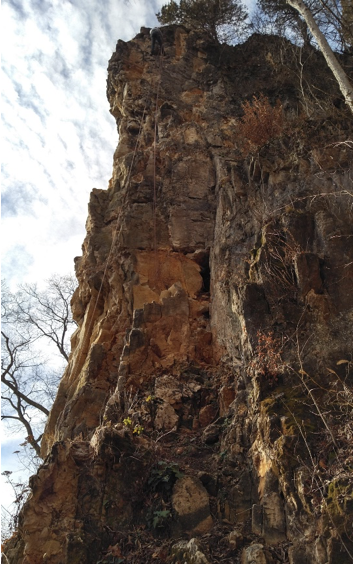 Vertical Voyages' Jon Richard climbing the Paleozoic-age Potosi Formation. Vertical Voyages' Jon Richard climbing the Paleozoic-age Potosi Formation. Standing like a fortress facing east, Robinson Bluff catches the first rays of morning sunlight. Turkey vultures gather on bare tree limbs to shake off the morning cold. For a moment, nothing moves except for the cold water of the Big River meandering through the valley. Located about an hour from St. Louis, Robinson Bluff feels like a temporal anomaly. On the brochure it states “more climbing, less driving.” Climbers can spend the day choosing from more than 300 routes and still be back in time for dinner. But as the mist lingers on the river and light slowly spills into the valley, time stands still. In this stillness, a greater appreciation of the unique geological past of this climber’s haven can be had when pausing to contemplate how time and change has affected everything around you. Plus, it is shaping up to be a beautiful day to climb. Earth has a long history, spanning approximately 4.6 billion years. At Robinson Bluff, the story begins over 500 million years ago on the bottom of the sea floor. Today, the bluff may be crawling with climbers, but back in geologic time when these rocks were deposited, this area, now known as southeast Missouri, would have been covered by a tropical sea teeming with marine life. The Paleozoic Era The Cambrian Period was significant for many reasons. It marked the beginning of a new era in geologic time called the Paleozoic Era, meaning “ancient life.” Geologists sometimes refer to this period as the “Cambrian Explosion” because it is the time in earth’s history when nearly all major animal phyla appeared in the fossil record. Clues of this “biological big bang” can be found in Missouri’s rock record too. Remains of creatures such as trilobites, stromatolites and crinoids are just a few of the examples. The Paleozoic Era lasted for approximately 289 million years and ended with the biggest mass-extinction event in earth’s history, called the “Great Dying,” when about 90 percent of life in the oceans and 70 percent of life on land was wiped out. Geologists often say that “the present is the key to the past.” In late Cambrian time, several key factors came together to form the rocks at Robinson Bluff. For one, Missouri was a lot closer to the equator then. Warm, crystal-clear water covered most of the state which made Missouri more like the modern-day Caribbean. In the Bahamas today, the conditions are perfect for marine life. Millions of critters live out their days extracting calcium carbonate (CaCO3) from sea water to make the hard parts of their shells. Eventually, when the animals die, their remains sink to the sea floor where they collect in great numbers. Year after year, this cycle continues, forming what geologists refer to as the "carbonate factory.” Similarly, in the Cambrian Period, southeastern Missouri was host to a plethora of newly arrived marine critters. Over vast stretches of time, shell material from these animals accumulated in significant enough proportions and were buried so deeply that they eventually became lithified into the layers of rock we see today. It may be the last thing on a climber’s mind while ascending the route of choice, but Robinson Bluff is a Paleozoic graveyard. Over a hundred and twenty years ago, a geologist named Arthur Winslow trekked through the town of Potosi, Missouri while mapping lead and zinc deposits in the region. He noted a particular bluff-forming rock layer that was easy to identify due to its abundance of mineral blossom deposits, AKA quartz crystals. Using the name of the nearest town, Winslow mapped the geologic formation as the Potosi Dolomite. While they are both carbonates, dolomite is the magnesium-rich cousin of calcite. Calcite and dolomite are minerals that form the rocks limestone and dolostone. Calcite is to limestone as dolomite is to dolostone. Both rock types form in marine environments similar to that of the Bahamas. However, they are chemically different. Like most Paleozoic dolostones in Missouri, the Potosi Formation is believed to have been formed as a limestone that was later exposed to magnesium-rich waters and turned to dolostone. This dolomitization process yields an end product slightly harder than limestone, but for the most part, they look the same. Limestone and dolostone can also be differentiated with a drop of hydrochloric acid (HCl) on the rock surface. While limestone has a vigorous bubbling reaction, dolostone has a very feeble reaction, if any. Perhaps the single most diagnostic feature of the Potosi Formation is the abundance of druse quartz. Appearing about four bolts up from the trail surface on nearly every climb at Robinson Bluff are intriguing mineral clusters that line pockets in the rocks. Hard, crystalline druse quartz creates the sparkling, textured holds that are commonly found throughout the Potosi Formation that resemble the inside of a geode. It also weathers out of deep red, rather sticky clay, locally termed “tallow clay” or “terra rosa,” and can be found on the trails in the vicinity. Quartz is made of silica, or (SiO2), and is a much harder substance than its dolostone host rock. Those who have bolted at Robinson Bluff may have noticed that the upper half of the cliff is harder to drill. This is most likely due to the increase of silica content in the rock. Quartz is a seven on the Moh's Hardness Scale, a scale that geologists use to characterize scratch resistance of various natural materials relative to each other. The mineral calcite is a three on the hardness scale, and dolomite, which makes up most of Robinson Bluff, is three-and-a-half to four on the scale. Drilling through the rock here is a great way to become acquainted with the Potosi Formation and all its chemical nuances. The Mesozoic Era The end of one era is the beginning of another. The Paleozoic Era gave way to the Mesozoic, when all land masses had joined together like a global puzzle to form a supercontinent called Pangaea. This continental crash left an epic mark on the story of Robinson Bluff. About 280-230 million years ago, South and North America slowly collided to form a mountain range resembling the modern Rockies. This event is called the Ouachita orogeny. By the close of the Paleozoic, the Ouachita Mountains in Arkansas and the Wichita Mountains in Oklahoma were newly formed. The vast warm seas of the Paleozoic Era, that had covered Missouri slowly drained away. Today, these mountains still exist, but have weathered away to the roots. Oddly enough, the Ozark Plateaus now exhibit greater relief relative to the Ouachita Mountains that originally pushed them up. This continental collision helped shape the Ozark Region. During the Ouachita orogeny, the land surface was regionally uplifted to form the Ozark Dome. Granites, usually found deep beneath the Earth's surface, were exposed and weathered to reveal the very basement of the continent. On the southeast portion of the geological map of Missouri is a big red bullseye. This marks the core of the Ozark Dome; an igneous province called the St. Francois Mountains. Paleozoic sedimentary rocks encircle the St. Francois Mountains and dip away in all directions from the core. Faults crisscross the region and fractures in the rock became conduits for chemically rich fluids that precipitated all manner of valuable ore minerals, making Missouri one of the most historic mining districts in the country. Most major mountain ranges are associated with a plateau, which is a flat, elevated landform that rises above the surrounding area — the Rockies and the Colorado Plateau, for example. Although the deep valleys and rugged hills of the Ozarks feel like mountains at times, the Ozarks are technically three geologically different plateau surfaces, highly dissected by streams. Robinson Bluff is situated on the Salem Plateau, hosting the oldest-aged rocks of the three. Newton's Third Law of Motion states that for every action in nature there is an equal and opposite reaction. As the land surface was uplifted during the Ouachita orogeny, streams were working hard to erode downward to reach base level. Much of the landscape we see today in the Ozarks was formed by the action of streams reworking earth's surface by cutting through the bedrock. By the end of the Mesozoic Era, Pangaea broke apart and another mass extinction event swept the globe, ending the era of dinosaurs and giving way to the Cenozoic Era, what we consider to be recent life. The Big River, which is the largest tributary stream to the Meramec River, flows north from the core of the Ozark Dome, cutting through the sedimentary rock layers and exposing the majestic cliffs at Robinson Bluff. Water continues to play a major role in weathering the rocks at Robinson Bluff. Groundwater also plays a role in shaping the landscape and creating karst features in carbonate sedimentary rock. The entrance of River Bend Cave emerges near the base of the staircase. Closed to the public, this cave passage extends several hundred feet into the rock and is home to many interesting cave features. After a hard rain, watch for springs pouring from the rock near the cave entrance. Springtime at Robinson Bluff Our journey through geologic time brings us to springtime at Robinson Bluff. On a sunny afternoon in late March, bloodroot flowers are just opening their petals, and in a few weeks, the leaves will unfurl. Climbers, whether or not they realize it, are similar to geologists. Though they use a different vocabulary for the rocks, they make similar observations.
From the bottom of the seafloor to towering bluffs, from ancient oceans to Ozark streams, time and change are everything at Robinson Bluff. James Hutton, the father of geology once said, "It's the little causes, long continued, which are considered as bringing about the greatest changes on earth." Each trip to Robinson Bluff is a chance to learn and discover something new. This incredible geologic and recreational resource has something to offer everyone. Robinson Bluff continues to evolve into more than a Missouri rock climbing destination; its recent unveiling of mountain biking trails adds miles of new downhill adventure. In addition to a two-mile cross country loop, the park’s 11 downhill trails offer beginner-to-advanced riders a hefty number of natural and built features. It’s not just the uniqueness of these features, but also the sheer quantity that make the new bike park a worthy attraction in-and-of itself. While the St. Louis mountain biking scene has a lot to offer, Robinson Bluff’s trail builder, Eric Lewis, says these new trails are unlike any of the other local trail systems. “There isn’t anything like it in St. Louis,” Eric said. “We’ve had some ex-pro riders test out the jumps and they agree.” That’s because Eric fashioned them after Colorado’s famed downhill trails. “I got a lot of ideas in Colorado,” he said. “When I came back, I knew exactly what I wanted to build.” Trail Guide
The six miles of new trails at Robinson Bluff include three machine-built flow/jump downhills, eight single track downhills and a cross country loop. The mountain bike trails start to the right of the pay station. Each of the numbered trails is marked with signs and is color coded. Black Diamond Trails Robinson Bluff’s three most difficult trails are steep and technical with tight corners, ledge drops and rocky, off-camber sections.
Blue Trails The eight, intermediate single-track trails are decked out with small berms, rock gardens and natural rock ledge jumps.
Green Trails
Multi-Sport: Climb, Bike, Hike, Fish, Paddle, Camp, Climb In addition to the new mountain biking trails, Robinson Bluff is a destination for hiking, fishing, paddling, camping, and, of course, rock climbing. Thanks to volunteers like Eric -who has also set more than 25 stellar sport routes at Robinson Bluff - our Midwest multi-sport destination continues to evolve into a place for outdoor adventure enthusiasts and adrenaline junkies. As such, there’s just too much to explore in a single day; check out all the ways to stay at Robison Bluff when you aren’t ready to leave! Robinson Bluff is a privately owned rock climbing and mountain biking destination. Completing a waiver and paying the $10 per person daily entrance fee is required to participate in any — or all — of the property’s activities, with the exception of camping, which is $10/night per campsite. Whether you’re the tent type, the cabin-only climber or camper van vagabond, Robinson Bluff has the right setup for your week or weekend of rock climbing. Choose from these three ways to stay: Tent Camping Robinson Bluff’s campground has 21 primitive, wooded campsites with fire ring and natural seating. Sites are a quick walk from our brand new restrooms with potable water and shower; even closer is the maintained, portable restroom at the top of the grand staircase. Sites are available on a first come first serve basis, and can accommodate up to 6 people per campsite. The main gate stays locked, so be prepared to haul your things to your campsite (approximately 500 yards) or email [email protected] ahead of time to request the gate code. Campers looking for a different landscape, and who are willing to hike their gear further, may want to camp along the gravel bar next to the river. Cost to camp: $10 per site per night Camper Van or Car Camp With a large, level gravel parking lot, Robinson Bluff is equipped to handle camper vans, small RVs and travel trailers up to 19 feet. While not the same wooded surroundings as the tent camping, nearby trees offer some shade. No electric, water or sewer hookups, but the brand new restrooms with potable water and showers are located right across the street from the parking lot. Be aware that camper vans, RVs and travel trailers will not be able to make the loop in the campground. Cost to camper van, RV or car camp: $10/vehicle Cabin Rental For those who prefer more in the way of amenities, the Camper’s Cabin is a quick walk or drive down the gravel road past the parking lot. The brand new, rustic cabin comes with a fully stocked kitchen, laundry, fire pit and BBQ grill. It accommodates up to four people, with two lofts, the queen bed is accessible via a one-of-a-kind cedar-carved staircases and the two twins via a climbing wall or built-in ladder. With more cabins on the way, this rustic bungalow is currently the only one available to rent on AirBnB. Perfect for Robinson Bluff rock climbers who prefer a crag-side cabin over camping. Check AirBnB for availability and pricing Climb more. Drive less.
With 220 sport routes and bouldering problems, development at Robinson Bluff’s 3,615 feet of bluff line is always happening. In addition to fantastic rock climbing, Robinson Bluff guests also have access to hiking and mountain biking trails, as well as the Big River. Whether you stay at Robinson Bluff in a pup tent, pop up or “penthouse,” we’ve got you covered when you aren’t ready to leave! Meet robinson bluff's most prolific route setter: Chuck McGibbonIf you’ve rock climbed much at Robinson Bluff, you’ve probably seen Chuck McGibbon crowbarring boulders off the wall, using a leaf blower thirty feet up, and drilling hole after painstaking hole while dangling in space. He is hands-down Robinson Bluff’s most prolific route setter, having established nearly 30 percent of our 178 sport routes.
With his stockpile of first ascents, you’d think he had been climbing and setting his entire life, but Chuck and his wife, Becky, both started rock climbing in their 60s. Before technical rock climbing, Chuck mountaineered fourteeners like Mounts Shasta (14,179’) and Rainier (14,411’) before tackling North America’s highest peak, Denali (20,310’). Then, he took on the world’s tallest peaks with Ama Dablam (22,349’) in Nepal, Aconcagua in Argentina (at 22,837’ it is the tallest mountain outside of Asia), and Cho Oyu (26,864’) in Tibet before training for the “roof of the world," Mount Everest, where in 2007, he reached its south summit (28,704’). A year later, Chuck traded his high altitude career for a shorter, more affordable variety of climbing, technical rock climbing. He was 63. As with most new climbers, 5.9s felt out of reach, but that didn’t last long. “I was inspired by Jack LaLanne (the godfather of modern fitness). When he turned 70, he towed a flotilla of 70 rowboats across Long Beach Harbor. I wanted to do something like that in my 70th year, too. So, I decided to try to red point at least 70 routes that are at least a 5.11a grade. I passed that goal with 84 before turning 71, and I just kept climbing and counting.” Rock Climber to Route Setter In 2017, Chuck and Becky visited Hobart, Tasmania for the second time. While Chuck had spent much of their first trip to the Australian island climbing on dolomite on nearby Mount Wellington, the second trip offered something new — recently discovered sandstone cliffs in the Sand River area. His mates invited him to help develop this new climbing area. When he returned home, he wasn’t planning on using his new setting skillset. But then… “I was climbing with Bill Weishaar one day at Robinson Bluff,” said Chuck. “Bill asked if I was interested in setting routes there. The Covid pandemic was just starting, and I didn’t want to be stuck inside during it, so I agreed to give it a try. I just loved going down there. Still do.” …so much so, he’s made more than 250 trips here! While some of those were just to climb, the number of outings certainly speaks to the time commitment required to do what he’s done. Chuck says he spends three or more, eight-hour days setting a single-pitch route. Applied to Robinson Bluff’s total number of sport routes, that’s more than 4,400 hours of cleaning, hammering, chain sawing, anchor building, sequencing, planning, drilling, gluing and everything else that goes into route setting. Thank you to every single one of our route setters! We recognize the significant time commitment you’ve given to set good routes. And we have a lot of good routes! Route Setting at Robinson Setting a route starts with finding an inspiring line. Then cleaning the rock. And finally, placing anchors and bolts. That’s about as basic an explanation as it gets. But there are many other steps and jobs as well (see 4,400 hour notation). “Sometimes, there’s a lot of brush to remove,” said Chuck. “Some of it is easy (think pebbles, dirt, leaves, vines, poison ivy); other times, it might be an entire tree.” Trading his chainsaw for a hammer and crowbar, Chuck then begins inspecting and pounding on the rock, checking for fractures, loose rock, and cavities. At Robinson Bluff, if it moves, it gets removed. “Then, I figure out how I’d climb it and where the anchors should go. I try it on top rope and a fixed line a few times (he always sets from rappel), looking for decent rock to place the bolts. Then, I start drilling and gluing.” In addition to his 50+ route contribution to Robinson Bluff, Chuck spends days — literally days — cleaning routes he hasn’t set, retrofitting anchors with mussy hooks, building and clearing trails, hand-crafting name plates for routes, and all around making the property better for climbers. Next time you see Chuck dangling along Robinson Bluff’s cliffs…first, watch out…then thank him. |
Archives
October 2022
Categories |

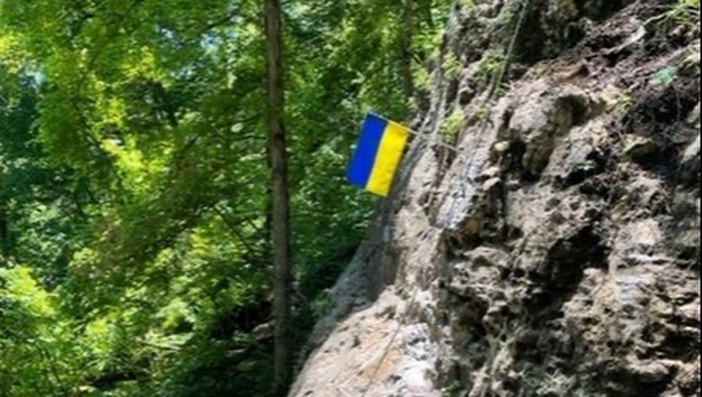
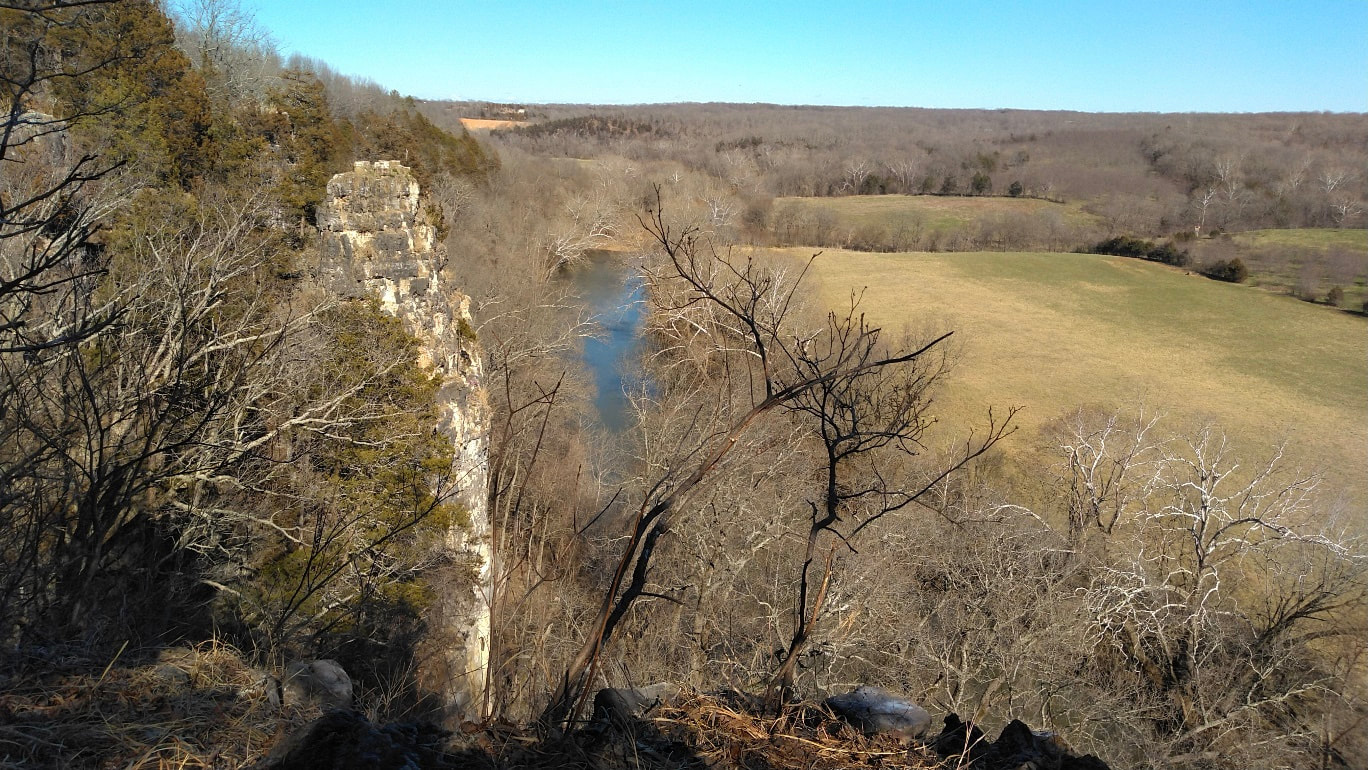
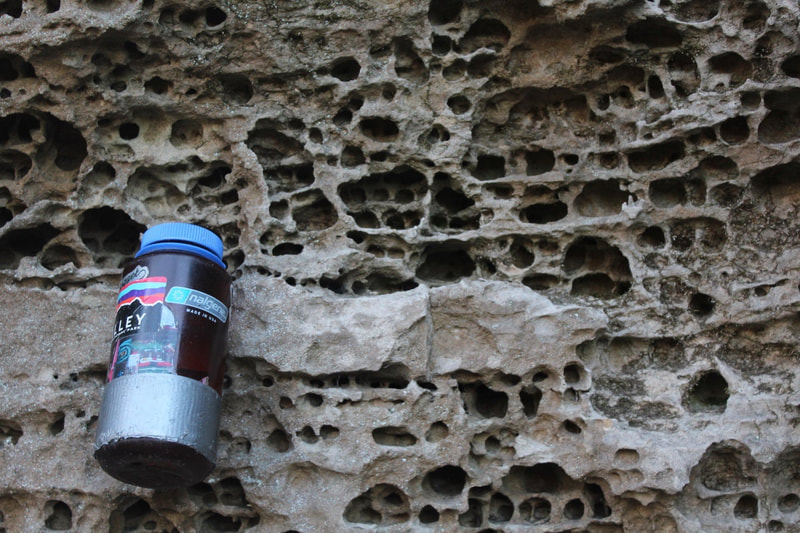
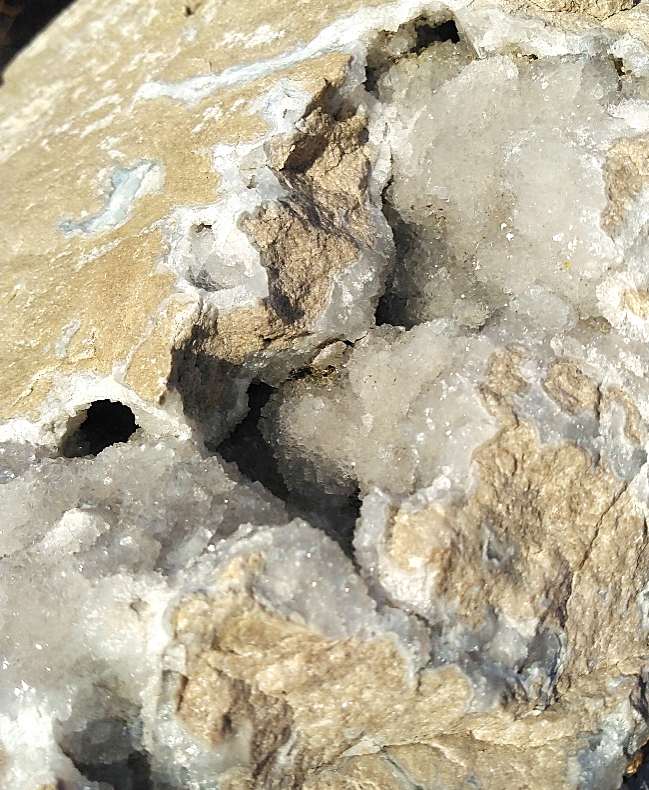
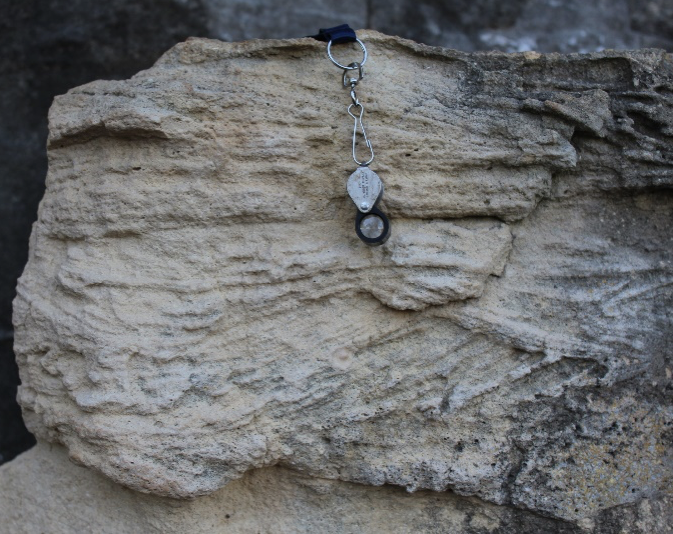
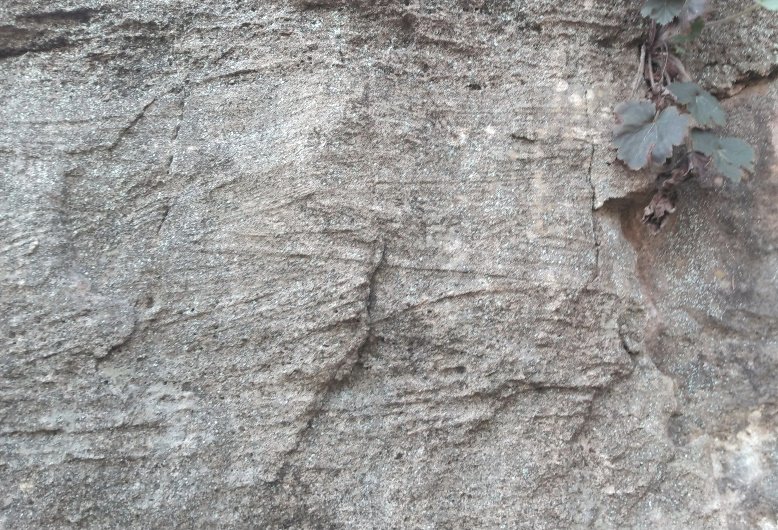
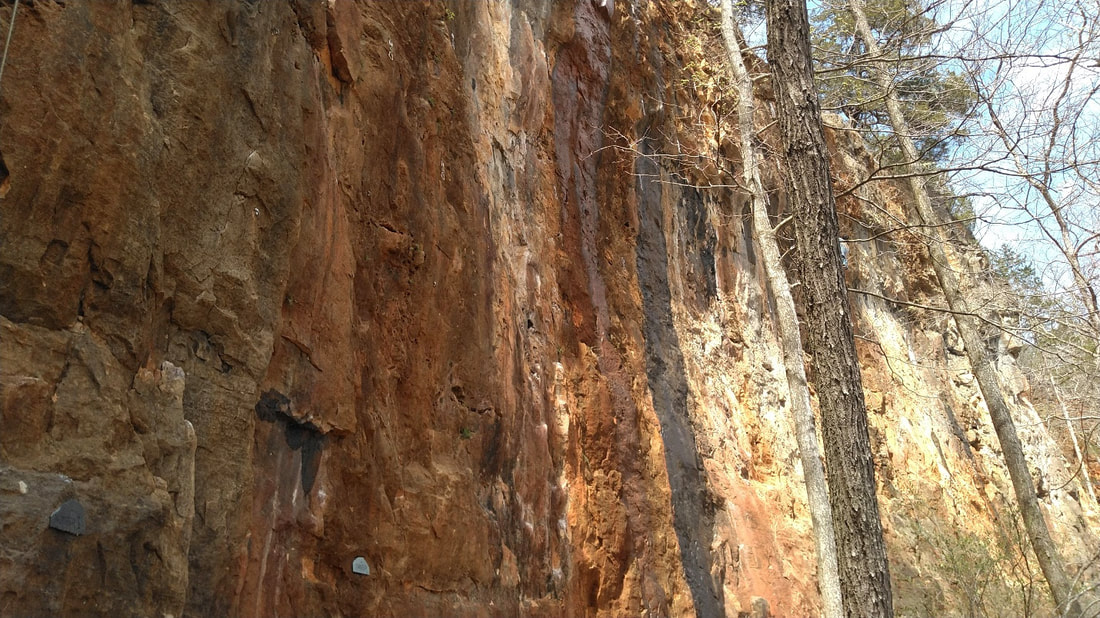

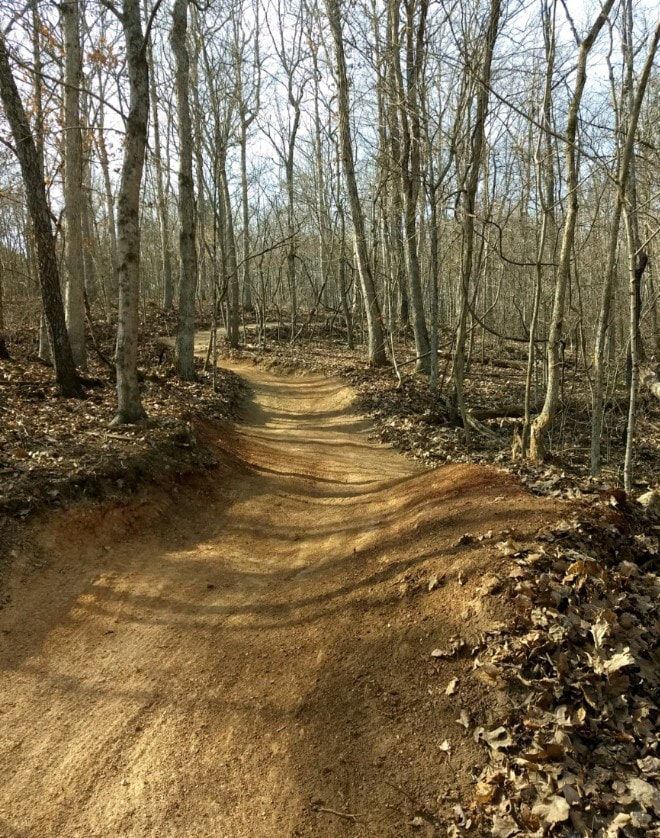
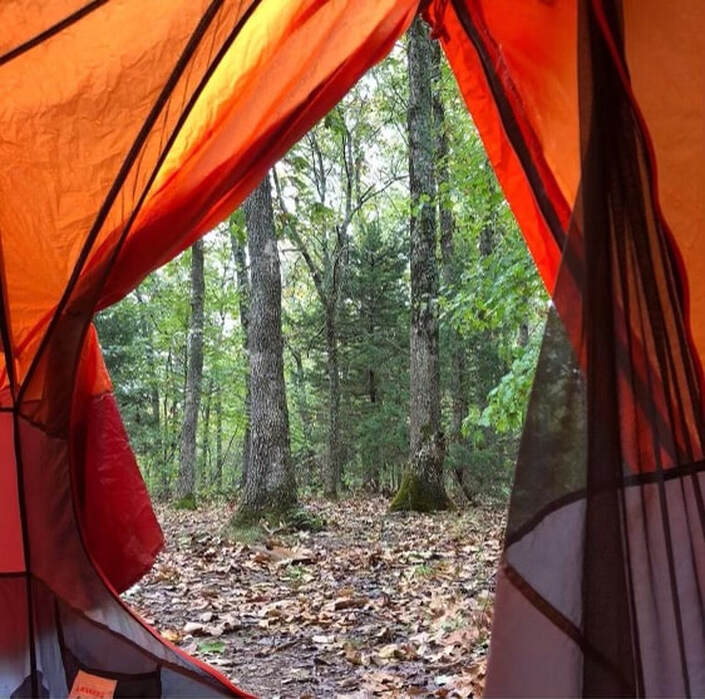

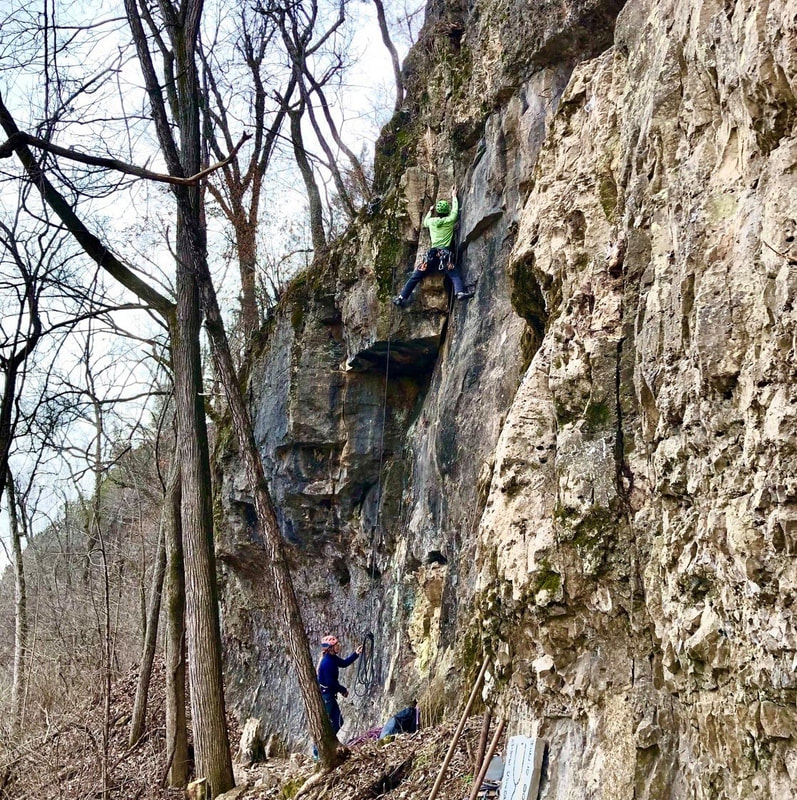
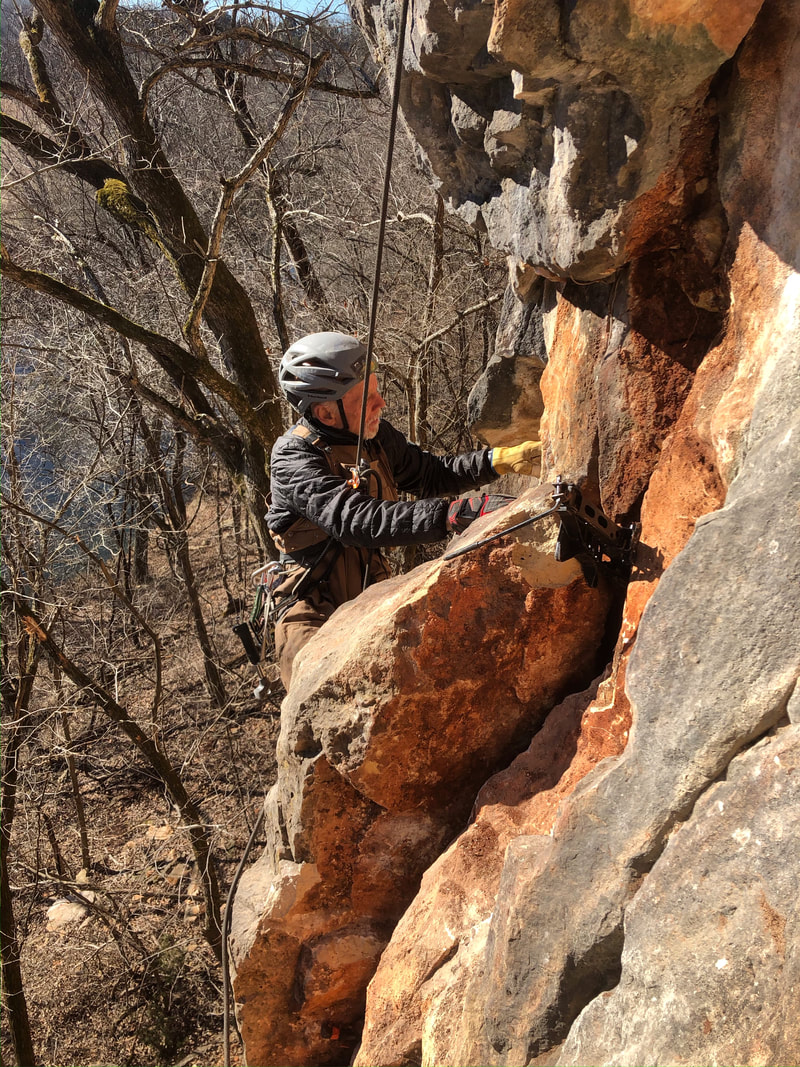
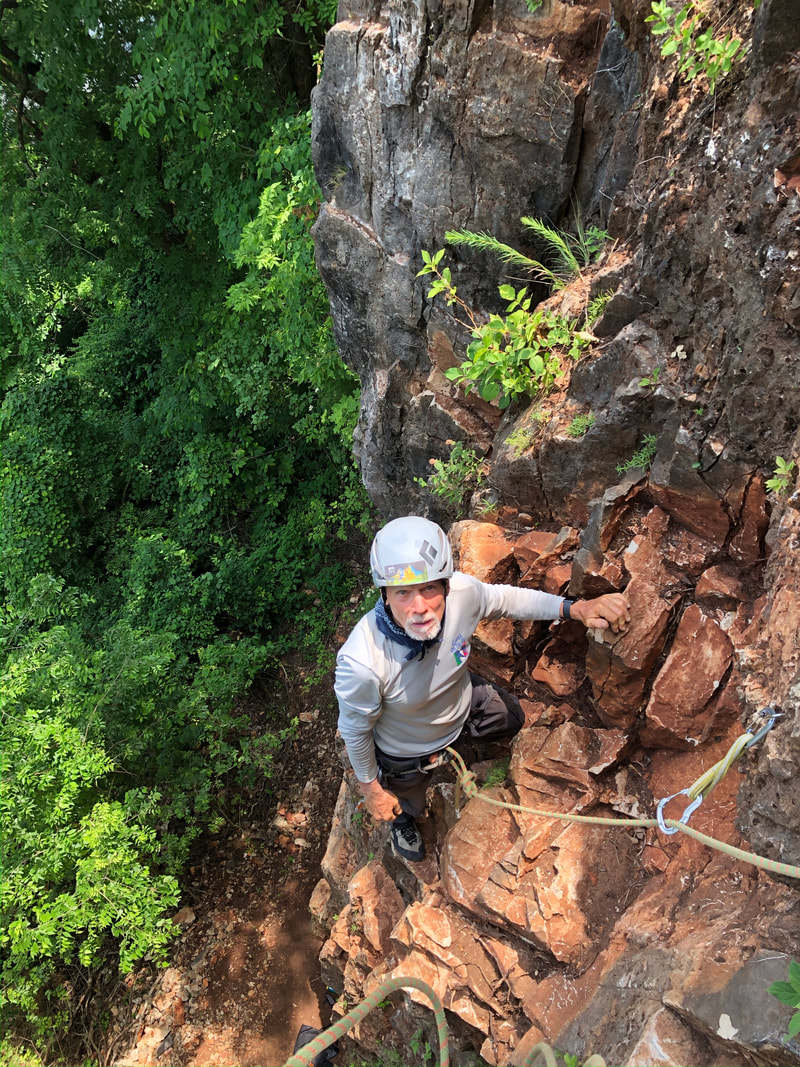
 RSS Feed
RSS Feed